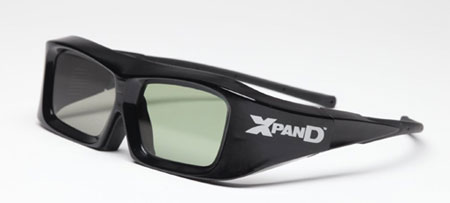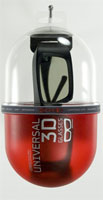With 3D TV, you really need to see it to believe it, and to see it you need not only the 3D-enabled HDTV, the Blu-ray 3D player (or 3D-capable set-top box) and supported software, but you also need those pesky 3D glasses. In fact, without glasses, a 3D TV is just an expensive 2D TV. And since most 3D TV sets still are only coming with a pair (or maybe two pairs) of glasses, you'll need to pick up a set of glasses for all the eyes in the house, as well as any potential visitors. Well, if you want them to be able to enjoy 3D content, that is
The other problem remains that glasses from one manufacturer will not work with other manufacturers' 3D TVs, although there are still many misunderstandings of this simple fact of 3D glasses incompatibilty. However, a couple of manufacturers have announced true universal 3D glasses options, that are said to work with any manufacturer's active shutter-based field-sequential 3D TVs. XpanD was the first to announce plans for universal 3D glasses (though Monster was not far behind). These new glasses, XPanD's X103 model, are designed to work seamlessly with the broadest range of 3D-ready TVs as well as Xpand 3D cinema.

To date the Xpand X103 Universal 3D glasses are the only 3D glasses that are claimed to work with all 3D TV brands and models,* as well as 3D computers, 3D gaming consoles and 3D cinema. Currently the Xpand 3D technology is being used in more than 3,000 3D cinemas in more than 50 countries. And now, 3D TV early adopters can order their own pair of the X103s as they're available (at a discounted price, no less) for pre-order on Amazon.com.

"The most anticipated product in the history of 3D is now a reality," says Maria Costeira, CEO of XpanD. "The introduction of the XpanD Universal 3D Glasses represents a watershed moment in consumer electronics, as I am confident the glasses will serve as catalysts in the worldwide adoption of 3D systems for the home."
Retailers are also hoping that the XpanD Universal 3D glasses will help drive sales of 3D-ready sets this holiday season.
Where to buy:
*Editor's Note: despite XpanD's claim of "universal compatibility," the X103 is designed to work only with emitter-based systems (separate IR emitter, or emitter built into the TV). This includes most if not all of the current 3D-ready flat panel TVs on the market such as Panasonic, LG, Samsung, Sony, Toshiba, etc. The X103 is not designed to work with the emitter-free "DLP-Link" standard found on DLP-based front and rear projection systems. DLP Link sends the 3D synch signal in the blanking interval between frames so it does not require a separate emitter. Owners of DLP-based projection systems without a separate emitter will need to wait for the upcoming X104 3D glasses from XpandD, which add DLP Link support to the mix. These are expected to be available in early 2011. Thanks to forum member "horsnfan" for reminding us of this important point.